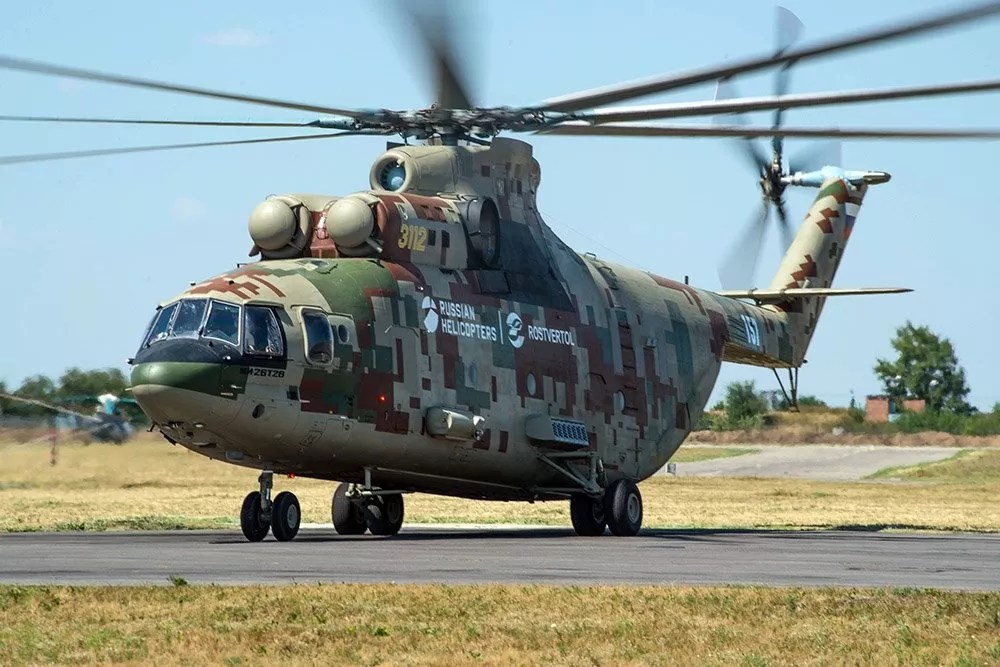The Indian Air Force’s unit operating the American Chinook will overhaul its fleet of Soviet-vintage Mi-26 super heavy lift helicopters. Built by Russian Helicopters, a subsidiary of Russian industry giant Rostec, the Mi-26 carries more cargo or people than any chopper in the West.
Even four decades after it took to the sky for the first time, the IAF’s Mi-26-operating unit, ironically called ‘Featherweight,’ is seeking to refurbish the fleet grounded for a long time.
It became a game changer for India in the Kargil war in 1999 by airlifting the howitzers to forward locations. And the force has no helicopter in its inventory that can airlift the Bofors gun weighing 11,700 kg in a single sortie.
The Indian newspaper, The Tribune, reported that a team of Russian technicians has been in Chandigarh to finalize the modalities of the project, and the contract is expected to be inked within a few months.
“We expect things to be finalized in about three months, and the overhaul after that is expected to be complete in about a year after the contract is signed,” an IAF official said. The helicopters are estimated to remain airworthy for another 10-12 years.
The overhauling is expected at 3 BRD in Chandigarh, even though certain spare parts might be required to be flown in from Russia. The option became the most efficient after the IAF explored sending helicopters to Russia by ship.
The deal has been in limbo for quite some time now. The entire Mi-26 fleet was grounded in 2017 and must be ferried to Russia for refurbishment. The IAF had inducted four Mi-26 super heavy lift helicopters, known by NATO as the ‘Halo,’ in 1986. It is known as a ‘sky crane’ for its heavy lift capabilities.
Two Lotarev D-136 turboshaft engines power the Mi-26. Each engine can produce 8,380kW of power. The Mi-26 can fly at a maximum speed of 295km/h and a cruise speed of 255 km/h.
The range and service ceiling of the helicopter is 1,952 km and 4,600 meters, respectively, while its hover ceiling is 1,700m. The aircraft weighs around 28,200 kg, and its maximum take-off weight is 56,000 kg.
First produced in 1980, the Mi-26 was designed and built by the erstwhile Soviet Union. The Mi-26 is vast, with a fuselage of 110 feet long and a maximum overall length, with rotors spinning, of 131 feet. The “Halo” can lift to 22 tons. The Mi-26 can accommodate 82 combat troops or more than a hundred civilians.
One of the most impressive features of the Mi-26 is its engine load-sharing technology. Even if one of the engines malfunctions, the helicopter can continue flying, ensuring that critical missions can still be carried out despite unexpected technical difficulties.
The twin-engine rotary fleet has been mired by poor serviceability in the 1990s, often attributed to the disintegration of the USSR. In the 1990s, as many as three out of four helicopters were on the ground. Also, the helicopters were underutilized. Against a projected utilization rate of 50 hours per month per helicopter, the helicopters flew for about 11 to 22 hours per month.
For every overhaul, the helicopters had to fly to Russia, taking excessive time. It was one of the primary reasons for the IAF to opt for Chinook and also that the ‘flying cow,’ another name given to this helicopter for its sheer size, is that it is an oil guzzler.
The low serviceability resulted from the USSR’s disintegration and a simmering relationship between Russia and Ukraine. The absence of Mi-26 was felt during the tension along the eastern border with China in 2020.

Russia Giving New Lease Of Life To ‘Halo’
The Mi-26 flew for the first time on December 14, 1977, and the Soviet Union’s sole goal was to build a helicopter with the same capacity as a four-engine Antonov An-22 turboprop. Unlike the massive Antonov, the chopper did not need a runway, making it ideal for working in remote locations. Also, it should be big enough to carry intercontinental ballistic missiles.
As reported by the EurAsian Times earlier, Russia has already modernized its Mi-26s. A new engine has powered the T2V variant of the chopper and boasts of the latest electronics, avionics, an advanced communications suite, navigation equipment, better ergonomics, and improved pilot infrastructure.
These systems enable automated flight along preset routes, allowing the helicopter to adjust its mid-air path and perform pre-landing maneuvers and diversions to alternate airports without pilot input.
Additionally, the helicopter has defenses against guided missiles and anti-aircraft weapons. It also contains upgraded night vision equipment and navigation and communications systems for connecting with satellites.
Reports indicate that the new Mi-26 has been armed with the Vitebsk Electronic Warfare Suite, the same EW that makes its Ka-52 ‘Alligator’ attack helicopter its teeth.
Deployment Of Mi-26
Mi-26s have seen varied deployments. After being used in Afghanistan in the 1980s to support the Red Army forces in the field, in 1986, the helicopters were used to drop sand and other protective materials on the site of the Chornobyl nuclear disaster. Those helicopters became unsafe to fly due to radioactive contamination.
In 2002, a Mi-26 airlifted a crashed US Army Ch-47 Chinook heavy lift helicopter in Afghanistan. In India, the ‘Featherweights’ have landed the chopper at Daulat Beg Oldie (DBO) and other high-altitude runways to transport wheeled vehicles, field guns, medium- and heavy-duty generators, mobile satcom stations, and bulldozers.
Operating Mi-26 alongside the US Chinooks will significantly lift the IAF’s strategic airlift capability. The helicopter can carry the same load as the C-130 J Super Hercules transport aircraft. It can have heavy vehicles like trucks and bulldozers in its fuselage.
- Ritu Sharma has been a journalist for over a decade, writing on defense, foreign affairs, and nuclear technology.
- She can be reached at ritu.sharma (at) mail.com
- Follow EurAsian Times on Google News